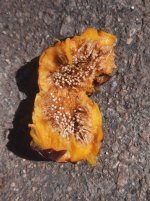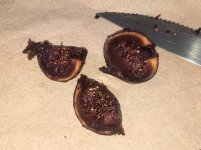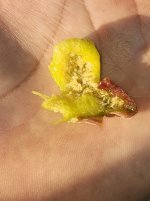Charlie Dodgson
Well-known member
In the biologic past prior to Ficus carica, Ficus were monoecious -- meaning that separate male and female syconia ("fruit") appeared on the same individual. Male flowers with stamens only occurred in male syconia. Female flowers with ova capable of fertilization only appeared in female syconia. The syconia were likely open with no ostiole (eye) -- which is generally common with compound flowers.
At some point a category of wasps began specializing in Ficus. In symbiotic response, the Ficus developed gall flowers with modified ova to host the wasps. These have no reproductive function and historically have been mislabeled as female.
The Ficus syconia then continued to evolve. One very noticeable feature is the closure of the sepals and the formation of the eye. Another adaptation is the transition from monoecy to dioecy.
Ficus carica is part way through this transition. As a result we presently observe female individuals with no male flowers, but we also observe Caprifig individuals with male flowers, true female flowers (typically fall crop), and gall flowers. These are true Caprifigs. A Ficus carica individual with no true female flowers in any crop is a male fig.
Beyond Ficus carica there are Ficus species which are believed to have completed the transition from monoecy to dioecy -- meaning all individuals are either male or female but gall flowers still occur in both. Ficus erecta is one of them.
At some point a category of wasps began specializing in Ficus. In symbiotic response, the Ficus developed gall flowers with modified ova to host the wasps. These have no reproductive function and historically have been mislabeled as female.
The Ficus syconia then continued to evolve. One very noticeable feature is the closure of the sepals and the formation of the eye. Another adaptation is the transition from monoecy to dioecy.
Ficus carica is part way through this transition. As a result we presently observe female individuals with no male flowers, but we also observe Caprifig individuals with male flowers, true female flowers (typically fall crop), and gall flowers. These are true Caprifigs. A Ficus carica individual with no true female flowers in any crop is a male fig.
Beyond Ficus carica there are Ficus species which are believed to have completed the transition from monoecy to dioecy -- meaning all individuals are either male or female but gall flowers still occur in both. Ficus erecta is one of them.





